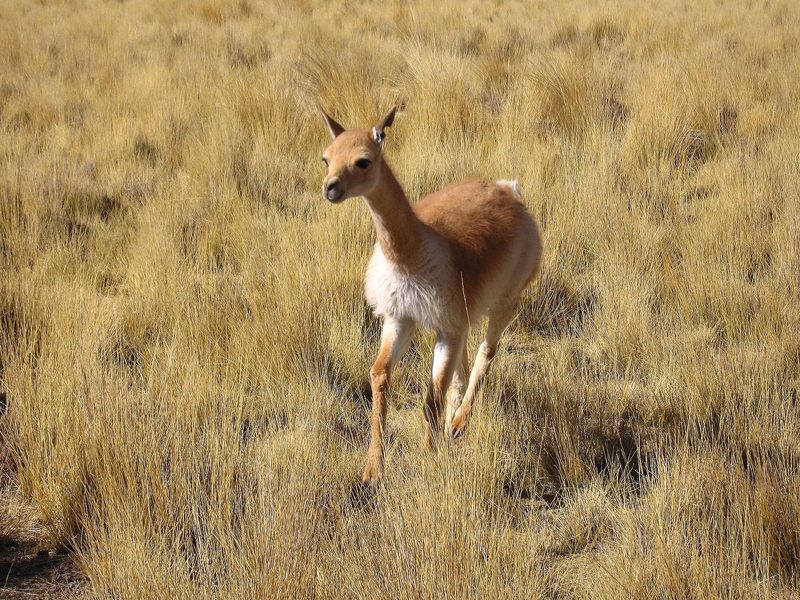|
| Query: camel | Result: 171st of 336 | |
Vicuna - Vicu??a (Vicugna vicugna) - Wiki
| Subject: | Vicuna - Vicu??a (Vicugna vicugna) - Wiki
| |

| Resolution: 1851x1388
File Size: 985427 Bytes
Upload Date: 2007:01:07 17:04:34
|
Vicu??a
From Wikipedia, the free encyclopedia
[Photo] Vicuna in the Humid Grass Pampa of the Argentine Altiplano. Female Vicu??a (Vicugna vicugna), 65°49'30W & 22°48'02S, 3,460 m a.s.l., 25.10.05 by Rico H??bner
The Vicu??a (Vicugna vicugna) is one of 2 wild South American camelids, along with the alpaca, which lives in the high alpineous areas of the Andes. It is a relative of the llama and the alpaca. Vicu??as produce small amounts of extremely fine wool. The Vicu??a's wool is very expensive because the animal can only be shorn every 3 years. When knitted together, the product of the Vicu??a's fur is very soft and warm. It is understood that the Incas raised Vicu??as for their wool, and that it was against the law for any but royalty to wear vicu??a garments.
Both today and under the rule of the Inca, the vicu??a was protected by law. In 1960 there were only about 6,000 vicu??as in the wild due to uncontrolled poaching ever since Spanish conquest of South America. Protection measures were carried out by Peru, Chile, and Argentina which raised their numbers up to 125,000. In Andean Bolivia the Ulla Ulla National Reserve was founded in 1977 partly as a sanctuary for the species. Although the recovery is somewhat comforting, these animals are still classified as vulnerable by the IUCN and endangered by the U.S. Department of the Interior.
Description
The Vicu??a is considered more delicate and graceful than the guanaco, and smaller. Its long, woolly coat is tawny brown on the back while the hair on the throat and chest is white and quite long. The head is slightly shorter than the Guanaco's and the ears are slightly longer. The length of head and body ranges from 1.45 to 1.60 m (about 5 ft); shoulder height from 75 to 85 cm (around 3 ft); weight from 35 to 65 kg (under 150 lb).
Distribution
Vicu??as live exclusively in South America, primarily in the central Andes. They are most commonly found in Bolivia, Peru, Chile, and northwest Argentina.
Habitat
Vicu??as live in grasslands and plains in the mountainous regions at an altitude of 4,000 to 5,500 meters. In these areas, only nutrient poor tough bunch grasses and festuca grows. The sun's rays are able to penetrate the thin atmosphere producing relatively warm temperatures in the day; however, the temperatures go back to freezing at night. The vicu??a's thick but soft coat is a special adaptation which traps layers of warm air close to its body so it can tolerate the freezing temperatures.
Behavior
The behavior of the vicu??a is similar to that of the guanaco. Vicu??as are very shy animals and are easily aroused by intruders. Like the latter, it will frequently lick calcareous stones and rocks, which are rich in salt, and it will also drink salt water. Its diet consists mainly of low grasses which grow in clumps on the ground.
The lives in family-based groups made up of a male, and 5 to 15 females and their young. Each group has its own territory of about 18km² this can fluctuate depending on the availability of food.
Mating usually occurs in March-April, and after a gestation period of about 11 months the female gives birth to a single young which it nurses for about 10 days; the young becomes independent at about 12 to 18 hours. Young males will form bachelor groups and the young females search for a sorority to join. Along with preventing intraspecial competition, it also prevents inbreeding which can cause a population bottleneck in endangered species as observed with cheetahs.
Domestication
Until recently it was thought that the vicu??a was not domesticated, and that both the llama and the alpaca were both descendants of the guanaco, a very closely related animal. But recent DNA research has shown that the alpaca may well have vicu??a parentage. Today the vicu??a is mainly wild, but the local people still perform special rituals with these creatures, including a fertilty ritual.
http://en.wikipedia.org/wiki/Vicuna
| The text in this page is based on the copyrighted Wikipedia article shown in above URL. It is used under the GNU Free Documentation License. You may redistribute it, verbatim or modified, providing that you comply with the terms of the GFDL. |
|
Comments |
|---|
| | Guest |
|
Vicuna (Vicu??a)
Vicugna vicugna
The vicuna is a member of the camel family. It is the smallest of the six species of camel, and is thought to be the wild ancestor of the alpaca. Vicuna lives on the high, grassland plateaus of the Andes mountains which range from southern Peru to northern Chile and into parts of Bolivia and Argentina. Only tough bunch grasses and festuca grows here. The sun's ultraviolet rays burn through the thin atmosphere during the day. At night the heat of the day escapes into the atmosphere and the temperatures go down to freezing. |
| | Guest |
|
Vicuna
A rare animal whose fiber makes the world's most costly and most exquisite cloth, surpassing all others in fineness and beauty. The vicuna is found in an almost inaccessible area of the Andes Mountains, at altitudes between 16,000 and 19,000 ft (4876 and 5791 m). The vicuna, one of the wildest of animals, is less than 3 ft (0.9 m) high and weighs 75-100 lb (33.7-45 kg). |
^o^
Animal Pictures Archive for smart phones
^o^
|
|
|